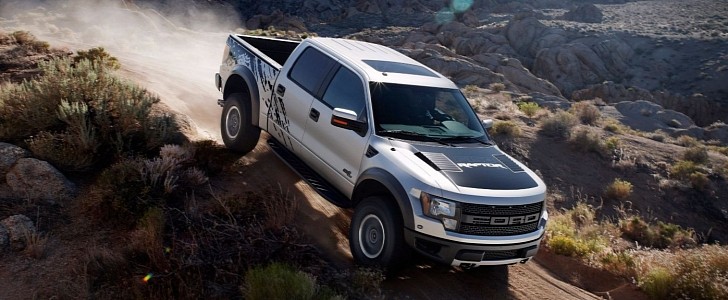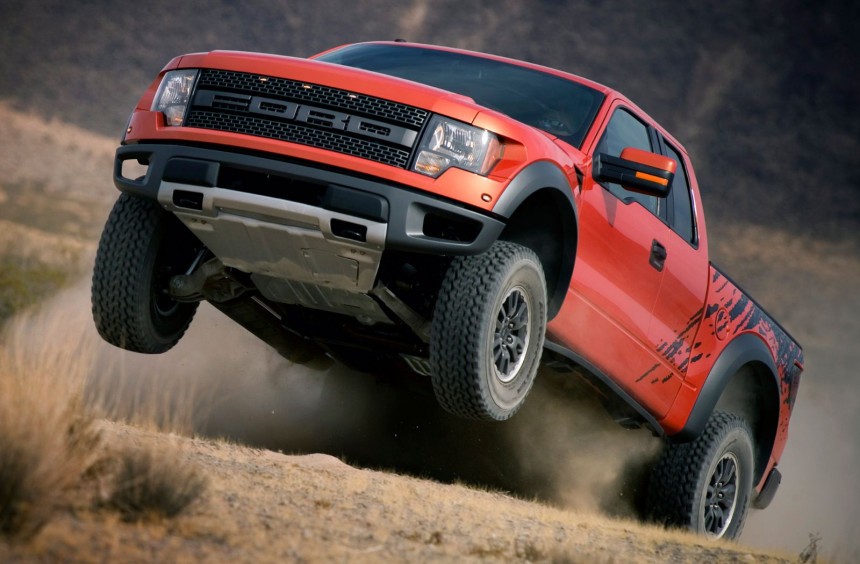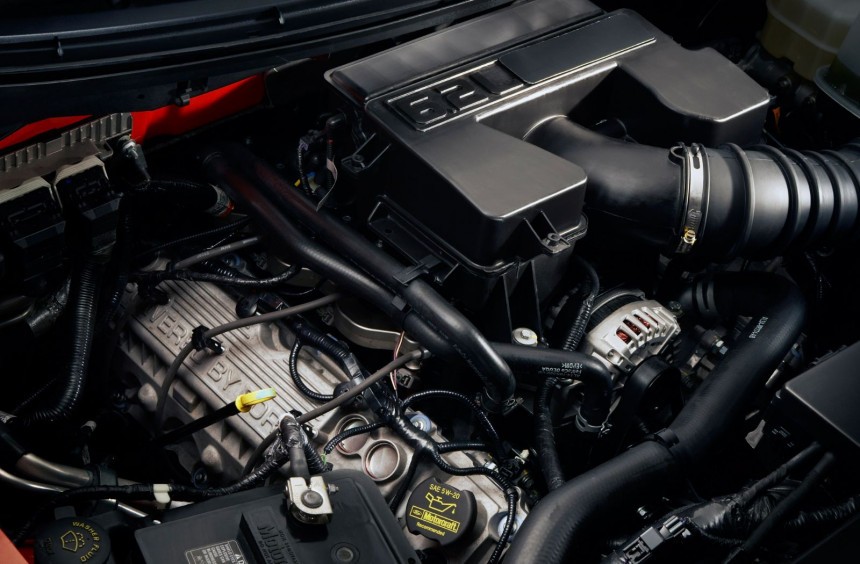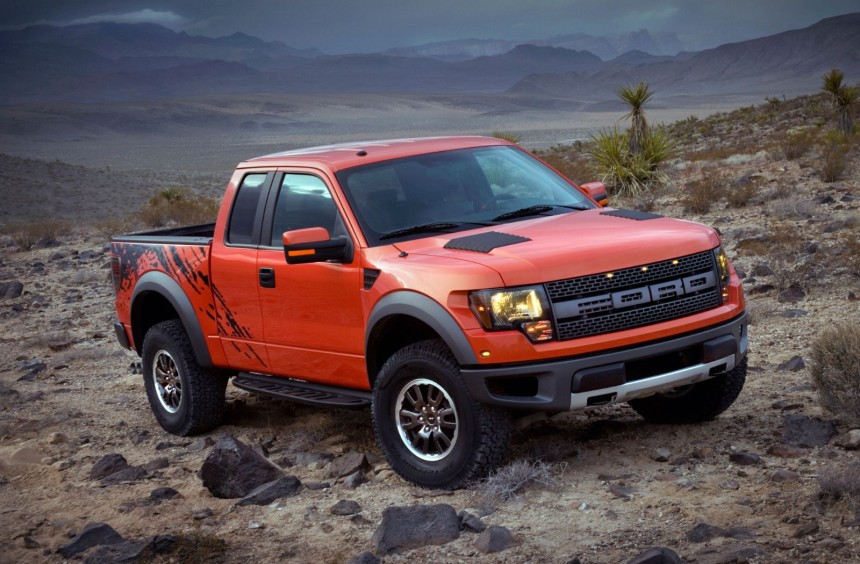Although enthusiasts have been transforming pickup trucks into high-performance monsters since the ‘30s and ‘40s, the first factory-built model came in 1978. Called Dodge Li’l Red Express, it hid a massive V8 under the hood that was capable of delivering around 225 hp.
Its success inspired the creation of other outrageous variants in the decades that followed, like the Ferrari-slaying 1991 GMC Syclone.
Ford’s first attempt to capitalize on this popular trend was the SVT Lightning, a sporty version of the legendary F-150 it produced in two generations, from 1993 to 2004. Like their predecessors, these super trucks were modified with street performance in mind, sacrificing any trace of off-road capability.
In 2008, four years after Chrysler decided to squeeze a Viper V10 inside a truck, the Blue Oval’s management instructed its Special Vehicles Team (SVT) to design a successor for the Lightning.
Jamal Hameedi, SVT’s chief engineer, along with senior exterior designer Bruce Williams and the development team in charge of the project decided that this time around, they would build a new kind of high-performance truck. They abandoned the idea of blending a pickup with a sports car and instead, opted to create a powerful off-roading beast.
Hameedi was no stranger to these kinds of vehicles, having worked on numerous trophy trucks in the past, but the rest of the team had zero experience with off-roaders. They spent the next year experimenting with different ideas which eventually morphed into the SVT Raptor unveiled in 2009.
Drawing inspiration from the most capable Baja racers of the day, it featured a highly modified long-travel suspension system equipped with Fox Racing bypass shocks with external reservoirs. The rear leaf springs as well as the front A-arms were redesigned, while the track was widened by 7 inches (17.8 cm) which helped raise the ride height by 2 inches (5 cm).
Initially, the truck came with either a standard 5.4-liter V8 that produced 320 hp and 390 lb-ft (529 Nm) of torque or an optional 6.2-liter borrowed from the Super Duty that could make 411 hp and 434 lb-ft (588 Nm) of torque. Regardless of the engine, power was transferred to all four wheels through a six-speed automatic, an open-differential front axle, and a rear locking differential with a 4.10:1 gear ratio. For the 2011 model year, the 5.4-liter was discontinued and a year later, the front axle received a new Torsen limited-slip diff.
Apart from these mechanical upgrades that made it the most versatile F-150 ever created, the SVT Raptor also received an aesthetic makeover that distinguished it from its standard siblings. Its front end only shared the headlights with the stock F-150. The grille was completely new and featured Ford lettering instead of the typical Blue Oval badge, the standard hood was replaced with a lightweight composite variant, and the fenders were wider to accommodate the big BFGoodrich KO tires.
Available in a 2+2 door SuperCab or a four-door SuperCrew (since 2011) configuration, the truck came with a short 5.5-foot (1.67 m) bed that was also modified to make room for the wider rear track and tires.
After it was released, people praised the off-road capabilities which you can admire in the video below posted on YouTube by AutoweekUSA, but the most pleasant surprise was the comfortable ride it delivered on paved roads.
Because of its unparalleled versatility, the SVT Raptor was a major success for Ford which ended up assembling five of them per hour at the Dearborn Truck Plant in 2013. The last units were sold through 2014 and during the entire production run, more than 75,000 first-generation Raptors were built.
A second-generation model was launched in 2017 followed by the current third-generation which debuted earlier this year. A smaller Raptor based on the mid-size Ranger was introduced in 2019 and although it was never released in North America, it became extremely popular worldwide, most notably in Europe and Australia.
The success of this revolutionary truck inspired other manufacturers to develop off-road capable variants of their flagship pickup offerings, the most outstanding of which is the Ram 1500 TRX. Although it’s currently the undisputed champion of factory-built high-performance trucks, Ford is planning to dethrone the TRX whit the upcoming release of the V8-powered F-150 Raptor R.
Ford’s first attempt to capitalize on this popular trend was the SVT Lightning, a sporty version of the legendary F-150 it produced in two generations, from 1993 to 2004. Like their predecessors, these super trucks were modified with street performance in mind, sacrificing any trace of off-road capability.
In 2008, four years after Chrysler decided to squeeze a Viper V10 inside a truck, the Blue Oval’s management instructed its Special Vehicles Team (SVT) to design a successor for the Lightning.
Jamal Hameedi, SVT’s chief engineer, along with senior exterior designer Bruce Williams and the development team in charge of the project decided that this time around, they would build a new kind of high-performance truck. They abandoned the idea of blending a pickup with a sports car and instead, opted to create a powerful off-roading beast.
Drawing inspiration from the most capable Baja racers of the day, it featured a highly modified long-travel suspension system equipped with Fox Racing bypass shocks with external reservoirs. The rear leaf springs as well as the front A-arms were redesigned, while the track was widened by 7 inches (17.8 cm) which helped raise the ride height by 2 inches (5 cm).
Initially, the truck came with either a standard 5.4-liter V8 that produced 320 hp and 390 lb-ft (529 Nm) of torque or an optional 6.2-liter borrowed from the Super Duty that could make 411 hp and 434 lb-ft (588 Nm) of torque. Regardless of the engine, power was transferred to all four wheels through a six-speed automatic, an open-differential front axle, and a rear locking differential with a 4.10:1 gear ratio. For the 2011 model year, the 5.4-liter was discontinued and a year later, the front axle received a new Torsen limited-slip diff.
Available in a 2+2 door SuperCab or a four-door SuperCrew (since 2011) configuration, the truck came with a short 5.5-foot (1.67 m) bed that was also modified to make room for the wider rear track and tires.
After it was released, people praised the off-road capabilities which you can admire in the video below posted on YouTube by AutoweekUSA, but the most pleasant surprise was the comfortable ride it delivered on paved roads.
A second-generation model was launched in 2017 followed by the current third-generation which debuted earlier this year. A smaller Raptor based on the mid-size Ranger was introduced in 2019 and although it was never released in North America, it became extremely popular worldwide, most notably in Europe and Australia.
The success of this revolutionary truck inspired other manufacturers to develop off-road capable variants of their flagship pickup offerings, the most outstanding of which is the Ram 1500 TRX. Although it’s currently the undisputed champion of factory-built high-performance trucks, Ford is planning to dethrone the TRX whit the upcoming release of the V8-powered F-150 Raptor R.


















